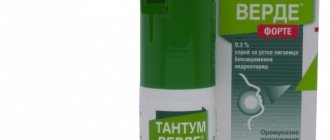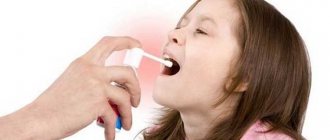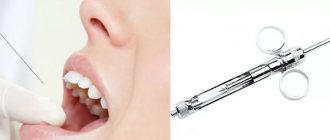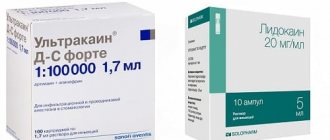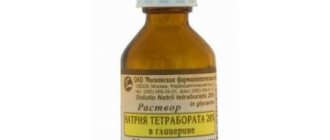From this article you will learn:
- what lidocaine-based drugs are used in dentistry,
- How much stronger is lidocaine than novocaine?
- What anesthetics are even stronger than lidocaine.
The article was written by a dental surgeon with more than 19 years of experience.
Lidocaine is a drug that is a local anesthetic, which is used for pain relief during the treatment and extraction of teeth, as well as when opening purulent abscesses. The analgesic effect of this drug is approximately 2 times higher than the effectiveness of novocaine, but 1.5-2 times inferior to ultracaine. For lidocaine, the instructions for use of the drug in dentistry contain information about the following forms of release:
- lidocaine in ampoules and carpules,
- lidocaine spray,
- lidocaine gel.
Below we will analyze in detail the use of each form, their pros and cons.
Lidocaine in ampoules -
Available in ampoules of 2 ml. Composition of the drug: 1 ml of solution contains 20 mg of lidocaine hydrochloride (this corresponds to a 2% solution), as well as excipients - 6 mg of sodium chloride and sodium hydroxide solution, + water for injection.
Lidocaine: reviews This anesthetic once replaced novocaine, and was several times stronger than it. You need to understand that novocaine has practically no effect in inflamed tissues during suppuration. The effect of lidocaine does not depend on the presence or absence of inflammation.
Typically, a dose of 4-5 ml of lidocaine is used for anesthesia in dentistry (if lidocaine is used without the addition of adrenaline). The duration of action from the moment of injection is from 30 to 90 minutes, which depends on numerous factors: the speed of blood flow, which washes the anesthetic out of the tissues, the type of anesthesia (in the upper jaw, anesthesia lasts significantly less than in the lower jaw with conduction anesthesia).
However, now we can safely say that lidocaine, like novocaine, are anesthetics of the past. Now it has been replaced by longer-lasting and deeper-acting anesthetics based on Articaine. These anesthetics include, for example, Ultracain, Septanest, Ubistezin and others. These anesthetics are several times stronger than lidocaine, and their duration of action is also several times longer.
The undoubted advantages of lidocaine include:
- low cost, which makes it a good free anesthetic in government clinics (10 ampoules cost about 40 rubles in a pharmacy),
- antiarrhythmic effect on the heart, which makes it the drug of choice for the treatment and removal of teeth in patients with cardiac arrhythmias.
Anesthesia in dentistry
The best drugs for local anesthesia in dentistry
As we said, most often in dental clinics drugs based on articaine are used, in particular Ultracaine or Ubistezin. Now, taking into account the information presented, it is time to dwell in more detail on the advantages of such anesthetics.
Artikain
Modern local anesthesia in dentistry is unthinkable without articaine. It is this anesthetic that has a minimal ratio of toxicity and analgesic activity. In other words, among the most effective remedies, it is the least toxic.
Articaine is actively used for infiltration and conduction anesthesia. It is also used for intraosseous anesthesia before dental operations. But the surface anesthetic effect of articaine is not typical, which is why it is not suitable for applications.
The advantage of articaine is its high effectiveness against inflammation. (The inflammatory process reduces the effect of many drugs). This feature allows the use of Ultracain or Ubistezin in the treatment of purulent-inflammatory diseases of teeth and periodontium.
Due to its low toxicity, articaine is the best remedy for pediatric dentistry, the elderly, and patients with diseases of the hepatobiliary and urinary systems. Can be used while breastfeeding. Articaine practically does not penetrate into breast milk, and if it is found in it, it is in extremely low concentrations that have no clinical significance.
Can articaine be used during pregnancy? Studies have shown that although articaine crosses the placental barrier, it does not have a toxic or mutagenic effect on the fetus. Articaine can be used during pregnancy.
Lack of articaine in the average duration of action. It is quickly absorbed into the blood, quickly destroyed and excreted in the urine. This is partly due to the fact that articaine, like many local anesthetics, dilates blood vessels. For this reason, articaine is often used together with vasoconstrictors, which are already included in the drug. For example:
- Ultracain DS Forte, Ubistezin Forte contain adrenaline in a concentration of 1:100,000 (average concentration).
- Ultracain DS, Ubistezin contain adrenaline in a concentration of 1:200,000 (low concentration).
What if the patient belongs to a risk group and cannot be injected with an anesthetic with adrenaline? In this case, you need to use Ultracaine D - a drug with articaine without a vasoconstrictor component.
During pregnancy, it is recommended to use articaine in combination with adrenaline in low concentrations (Ubistezin, Ultracaine DS). Some experts believe that it is better not to use vasoconstrictors at all when treating pregnant women. Which option is better? The choice must be made taking into account individual characteristics. A woman should consult with specialists, including a gynecologist who monitors the pregnancy.
Lidocaine
Lidocaine is another popular and widely used drug, despite the fact that it is 2 times more toxic than procaine. The advantage of lidocaine is its average duration of action and more pronounced effect (it is 4 times stronger than procaine). The problem is that lidocaine dilates blood vessels, which requires the simultaneous use of high doses of a vasoconstrictor drug. For this reason, lidocaine is rarely used for conduction or infiltration, but is often used for superficial anesthesia.
Can lidocaine be used during pregnancy? We have already mentioned one drawback - the drug requires the use of adrenaline in high concentrations. The second disadvantage of lidocaine is that it is toxic, crosses the placenta and accumulates in the fetal liver. Considering the above, local anesthesia with lidocaine is contraindicated for pregnant women.
Mepivacaine
A unique drug, because it is the only anesthetic for local anesthesia with a vasoconstrictor effect. This feature allows the use of mepivacaine without a vasoconstrictor, which makes it the best tool for providing anesthetic benefits to patients at risk (diabetes, thyroid disease, hypertension and other cardiovascular diseases).
Mepivacaine is actively used for infiltration and conduction anesthesia. It is contraindicated during pregnancy because it penetrates the placental barrier and narrows the uterine arteries, which can lead to fetal hypoxia.
Anesthesia in pediatric dentistry
The problem of anesthesia in pediatric dentistry is quite acute, since it is psychologically and physically difficult for young patients to withstand a long treatment procedure. On the one hand, they are frightened by the noise of dental instruments, on the other hand, it is simply difficult for them to sit still for 40-60 minutes. In this regard, instead of local anesthesia, the dentist may recommend anesthesia.
Anesthesia in pediatric dentistry is carried out using a modern drug - Sevoran. Unlike the previously popular ZAX (nitrous oxide-oxygen mixture), Sevoran combines not only high efficiency (sufficient depth and duration of medicated sleep), but also maximum safety and a very “clean” recovery from anesthesia. After waking up, the child feels great; headaches, nausea or dizziness are extremely rare.
You can learn more about the methods of providing anesthesia in pediatric and adult dentistry at a consultation with a medical dentist.
Make an appointment
Lidocaine in carpules -
All modern anesthetics have not been produced in ampoules for a very long time; they are produced in disposable capsules. The carpule already contains a dose of anesthetic; it is inserted into the carpule syringe (Fig. 1), then a disposable very thin needle is screwed on, and the syringe is ready for anesthesia.
Lidocaine carpule and carpule syringe:
An example of lidocaine anesthesia in carpules is the drug Xylonor, produced by the French company Septadont. But carpules with lidocaine are also produced by other companies. To increase the duration and depth of anesthesia, in addition to lidocaine itself, the anesthetic carpules also contain special additives (epinephrine, adrenaline or norepinephrine), which constrict the blood vessels at the site of anesthesia, thereby preventing the rapid leaching of the anesthetic.
The use of carpule syringes and carpules greatly simplifies the administration of anesthesia for the doctor, and thanks to very thin needles, it reduces pain for the patient. Read all the most detailed information on modern anesthesia in our article: “Everything about anesthesia in dental practice”
Lidocaine spray 10% –
This is a metered spray for topical use. In dentistry, it is used to relieve pain in the oral mucosa (24stoma.ru). One press sprays exactly 4.8 mg of lidocaine. The canister contains 38 grams of lidocaine, which is enough for 650 doses. The spray also contains excipients such as: 96% alcohol, peppermint oil and propylene glycol. Pleasant to the taste.
Lidocaine spray begins to act within 1 minute after spraying onto the mucous membrane, and the effect itself continues for 5-6 minutes. The drug can also be used in children under 2 years of age.
Lidocaine spray: reviews instructions lidocaine spray includes the following areas of application of the drug in dentistry -
- reduction of the gag reflex during dental treatment (spraying on the root of the tongue),
- for superficial anesthesia of the oral mucosa before local anesthesia (in this case, the injection will not be so painful).
Lidocaine spray: price You can buy lidocaine spray in almost any pharmacy with a prescription for about 350 rubles. However, as a rule, you will never be asked for a recipe.
Lidocaine spray for local use. dosed 4.6mg/dose 38g
Registration Certificate Holder
SYNTHESIS (Russia)
Dosage form
Medicine - Lidocaine-Akos
Description
Spray for local and external use
in the form of a transparent, colorless or yellowish liquid.
1 dose
lidocaine hydrochloride monohydrate 4.6 mg
Excipients
: ethanol 96% (rectified ethyl alcohol, “Extra” grade) - 18.4 mg, propylene glycol - 4.6 mg, sodium hydroxide - 0.23 mg, sodium saccharinate dihydrate (sodium saccharin) - 0.138 mg, racementol (racemic menthol) - 0.092 mg, water purified - up to 0.046 g.
340 doses - plastic bottles with a spray nozzle (1) - cardboard packs. 650 doses - plastic bottles with a spray nozzle (1) - cardboard packs.
Indications
For terminal (superficial) anesthesia of mucous membranes: in dentistry, in otorhinolaryngology, in obstetrics and gynecology, for instrumental and endoscopic examinations, in surgery and dermatology, radiographic examination (elimination of nausea and pharyngeal reflex).
Contraindications for use
Use for tonsillectomy and adenotomy in children under 8 years of age;
hypersensitivity to lidocaine. With caution
during instrumental studies (rectoscopy) in patients with hemorrhoidal bleeding, local infection in the area of application, trauma to the mucous membrane or skin in the area of application, severe somatic pathology, epilepsy, bradycardia, cardiac conduction disorders, impaired liver function, severe shock, young children, elderly patients, during pregnancy and lactation.
pharmachologic effect
Local anesthetic for superficial anesthesia. The action is due to the blockade of voltage-dependent sodium channels, which prevents the generation of impulses at the endings of sensory nerves and the conduction of pain impulses along nerve fibers.
When applied topically, it dilates blood vessels and does not have a local irritating effect. Has an analgesic effect.
The effect develops 1-5 minutes after application to mucous membranes or skin and lasts 30-60 minutes.
Drug interactions
Cimetidine and propranolol reduce the hepatic clearance of lidocaine (decreased metabolism due to inhibition of microsomal oxidation and decreased hepatic blood flow) and increase the risk of toxic effects (including stunned state, drowsiness, bradycardia, paresthesia).
Barbiturates, phenytoin, rifampicin (inducers of microsomal liver enzymes) reduce effectiveness (an increase in dose may be required).
When prescribed with ajmaline, phenytoin, verapamil, quinidine, amiodarone, the negative inotropic effect may be enhanced. Co-administration with beta-blockers increases the risk of bradycardia.
Curare-like drugs enhance muscle relaxation.
Procainamide increases the risk of developing central nervous system excitation and hallucinations.
With the simultaneous administration of lidocaine and hypnotics and sedatives, their inhibitory effect on the central nervous system may be enhanced.
With intravenous administration of hexobarbital or sodium thiopental against the background of the action of lidocaine, respiratory depression is possible.
Under the influence of MAO inhibitors, the local anesthetic effect of lidocaine may be enhanced.
With the simultaneous use of lidocaine and polymyxin B, an increased inhibitory effect on neuromuscular transmission is possible, so in this case it is necessary to monitor the patient's respiratory function.
Dosage regimen
Apply locally, externally. The dose depends on the indications and the area of the anesthetized surface.
Side effect
Local reactions:
a slight tingling sensation that disappears as the anesthetic effect develops (within 1 minute); Transient erythema, swelling and sensory disturbances may occur.
Allergic reactions:
very rarely - urticaria, angioedema, bronchospasm; in exceptional cases - anaphylactic shock. The use of the drug should be stopped immediately if any allergic reaction occurs.
After topical application, systemic effects rarely develop, because
Only a very small amount of the active substance can enter the bloodstream. From the side of the central nervous system:
very rarely - nervous excitement, systemic dizziness, insomnia, loss of consciousness and respiratory paralysis.
From the cardiovascular system:
decreased blood pressure, depression of myocardial function, bradycardia, cardiac arrest.
special instructions
Use with caution in patients with epilepsy, as well as bradycardia, cardiac conduction disturbances, impaired liver function and severe shock, especially when significant amounts of the drug can be expected to be absorbed when large areas of tissue are treated with high doses.
It is important to prevent lidocaine from entering the respiratory tract (risk of aspiration).
Application to the buccal mucosa is associated with a risk of dysphagia and subsequent aspiration, especially in children. If the sensitivity of the tongue and mucous membrane of the cheeks is impaired, the risk of biting them increases.
Lidocaine is well absorbed through mucous membranes (especially in the trachea) and damaged skin. This should be taken into account, especially when treating large areas of tissue in children.
In cases of use during surgical operations in the pharynx or nasopharynx, it should be taken into account that lidocaine, suppressing the pharyngeal reflex, enters the larynx and trachea and suppresses the cough reflex, which can lead to bronchopneumonia. This is especially important in children, as they are more likely to trigger their swallowing reflex. In this regard, the spray is not recommended for local anesthesia before tonsillectomy and adenotomy in children under 8 years of age.
Caution should be exercised when applying lidocaine to damaged mucous membranes and/or infected areas.
Lower doses should be used in weakened and elderly patients, in acute diseases, as well as in children - in accordance with age and general condition.
Effect on the ability to drive vehicles and machinery
During the treatment period, care must be taken when driving vehicles and engaging in other potentially hazardous activities that require increased concentration and speed of psychomotor reactions.
Use during pregnancy and breastfeeding
Restrictions during pregnancy - With caution. Restrictions when breastfeeding - With caution.
If local anesthesia is necessary and no safer treatment is available, lidocaine can be used during pregnancy.
Lidocaine is excreted in breast milk, but after topical use in normal therapeutic doses, the amount excreted in milk is too small to cause any harm to a nursing infant.
Use for renal impairment
Restrictions for impaired renal function - With caution.
In chronic renal failure, accumulation of metabolites is possible.
Use for liver dysfunction
Restrictions for liver dysfunction - With caution. The drug should be used with caution if liver function is impaired.
Use in elderly patients
Restrictions for elderly patients - Use with caution.
Use with caution in elderly patients.
Use in children
Restrictions for children - Use with caution. Use with caution in children. Use for local anesthesia before tonsillectomy and adenotomy in children under 8 years of age is not recommended.
Lidocaine gel –
There are both professional lidocaine-based gels for dental clinics and those that can be bought at any pharmacy. An example of a common gel with lidocaine is the drug “Kamistad”. This gel contains lidocaine and chamomile extract as active ingredients. Created specifically for application to the oral mucosa. It has an analgesic and slight anti-inflammatory effect.
Lidocaine gel: price The cost of the drug Kamistad is about 230 rubles. If we talk about analogues for anesthesia of the mucous membrane, then the Cholisal gel has a slightly less pronounced, but longer-lasting analgesic effect. The latter also has a pronounced anti-inflammatory effect. The cost of the last drug is about 300 rubles.
Lidocaine spray for external and local use 10% 38g
Compound
Active substance: lidocaine hydrochloride monohydrate - 4.6 mg. Excipients: ethanol 96% (rectified ethyl alcohol, "Extra" grade) - 18.4 mg, propylene glycol - 4.6 mg, sodium hydroxide - 0.23 mg, sodium saccharinate dihydrate (sodium saccharin) - 0.138 mg, racementol (racemic menthol) - 0.092 mg , purified water - up to 0.046 g.
Pharmacokinetics
Rapidly absorbed from mucous membranes (especially the pharynx and respiratory tract).
The degree of absorption is determined by the degree of blood supply to the mucous membrane, the total dose, the localization of the site and the duration of application, the dosage form used. After application to the mucous membrane of the upper respiratory tract, it is partially swallowed and inactivated in the gastrointestinal tract. The time to reach Cmax when applied to the mucous membrane of the oral cavity and upper respiratory tract is 10-20 minutes. Protein binding depends on the concentration of the drug and is 60-80% at a drug concentration of 1-4 μg/ml (4.3-17.2 μmol/l). It is distributed quickly (T1/2 distribution phase - 6-9 minutes), first enters well-supplied tissues (heart, lungs, brain, liver, spleen), then into adipose and muscle tissue. Penetrates the BBB and placental barrier, secreted into breast milk (40% of the concentration in maternal plasma).
Metabolized in the liver (90-95%) with the participation of microsomal enzymes by dealkylation of the amino group and cleavage of the amide bond with the formation of metabolites that are less active compared to lidocaine (monoethylglycine xylidine and glycine xylidine), T1/2 of which is 2 hours and 10 hours, respectively.
Excreted with bile and kidneys (up to 10% unchanged).
In liver diseases, the metabolic rate decreases and ranges from 50% to 10% of the normal value.
In chronic renal failure, accumulation of metabolites is possible.
Indications for use
The drug can be used for local anesthesia in the following cases:
- in dentistry
- for terminal (superficial) anesthesia: anesthesia of the injection area before local anesthesia; opening of superficial abscesses; before suturing the mucous membrane; before fixing crowns and bridges; in the treatment of gum inflammation, periodontopathies; extirpation of baby teeth; removal of tartar;
- in otorhinolaryngology
- operations on the nasal septum and removal of nasal polyps; conducting electrocoagulation in the treatment of nosebleeds; elimination of the pharyngeal reflex and anesthesia at the injection site before removing the tonsils; opening of peritonsillar abscesses; puncture of the maxillary sinus;
- in obstetrics and gynecology
- egsiotomy and incision processing; removal of seams; minor operations on the vagina and cervix; rupture of the hymen; treatment of thread suppuration;
- for instrumental and endoscopic studies
- before inserting a probe through the nose or mouth (including duodenal intubation and fractional study of gastric secretion); during rectoscopy, intubation;
- during radiographic examination
- elimination of nausea and pharyngeal reflex;
- as an analgesic (pain reliever) drug
for burns (including sunburn); bites; contact dermatitis (including those caused by irritating plants); small wounds (including scratches);
- superficial anesthesia
of the skin during minor surgical interventions.
Contraindications
- hypersensitivity to lidocaine or any other component of the drug;
- use of lidocaine in the form of a spray for tonsillectomy and adenotomy in children under 8 years of age.
Carefully:
- instrumental studies (rectoscopy) in patients with hemorrhoidal bleeding;
- local infection in the area of application;
- trauma to the mucous membrane or skin in the area of application;
- severe somatic pathology;
- epilepsy;
- bradycardia, cardiac conduction disturbance;
- liver dysfunction;
- severe shock;
- concomitant acute diseases;
- weakened patients;
- pregnancy, breastfeeding period;
- younger children;
- elderly age.
Directions for use and doses
Apply locally, externally.
Dosage may vary depending on the indication and the size of the area to be anesthetized.
One dose of the spray, released by pressing the dosing valve, contains 4.6 mg of lidocaine.
Recommendations for the number of presses for various applications:
The drug can also be applied using a cotton swab soaked in it.
To avoid absorption of the drug into the systemic circulation, the minimum dose that ensures the effect should be used. Usually 1-3 clicks are enough; it is possible to use 15-20 or more presses (maximum dose - 40 presses per 70 kg of body weight).
In dental practice in children, it is preferable to use it as a lubricant (to avoid frightening the child when sprayed) by pre-impregnating a cotton swab.
Storage conditions
In a place protected from light, at a temperature not exceeding 25°C.
Keep out of the reach of children.
Best before date
3 years. Do not use after the expiration date stated on the packaging.
special instructions
When using, the bottle should be kept in an upright position.
Avoid contact with eyes and respiratory tract (risk of aspiration). Requires special care when applying the drug to the back of the throat.
Application to the buccal mucosa is associated with a risk of dysphagia and subsequent aspiration, especially in children.
If the sensitivity of the tongue and mucous membrane of the cheeks is impaired, the risk of biting increases.
Lidocaine is well absorbed through mucous membranes (especially in the trachea) and damaged skin. This should be taken into account, especially when treating large areas of tissue in children.
When using the spray during surgical operations in the pharynx or nasopharynx, it should be noted that lidocaine, suppressing the pharyngeal reflex, enters the larynx and trachea and suppresses the cough reflex, which can lead to bronchopneumonia. This is especially important in children, as they are more likely to trigger the pharyngeal reflex. In this regard, the spray is not recommended for local anesthesia before tonsillectomy and adenotomy in children under 8 years of age.
Caution should be exercised when applying lidocaine to damaged mucous membranes and/or infected areas.
The drug should be used with caution in patients with epilepsy, as well as bradycardia, cardiac conduction disorders, liver dysfunction and severe shock, especially when significant amounts of the drug can be expected to be absorbed when large areas of tissue are treated with high doses.
Lower doses should be used in weakened and elderly patients, in acute diseases, as well as in children - in accordance with age and general condition.
In children under 2 years of age, it is recommended to apply Lidocaine spray with a cotton swab dipped in the drug.
Description
Local anesthetic.
Dosage form
Spray for local and external use in the form of a clear, colorless or yellowish liquid.
Use in children
Contraindication: use of lidocaine in the form of a spray for tonsillectomy and adenotomy in children under 8 years of age.
Pharmacodynamics
Local anesthetic for superficial anesthesia.
The action is due to the blockade of voltage-dependent sodium channels, which prevents the generation of impulses at the endings of sensory nerves and the conduction of pain impulses along nerve fibers. When applied topically, it dilates blood vessels and does not have a local irritating effect. Has an analgesic effect.
The effect develops 1-5 minutes after application to mucous membranes or skin and lasts 30-60 minutes.
Side effects
At the site of application of the drug: a slight burning sensation that stops after the onset of anesthesia (within 1 minute), erythema, swelling, impaired sensitivity.
Allergic reactions: possible allergic contact dermatitis (hyperemia at the site of application, skin rash, urticaria, itching), angioedema, anaphylactic shock.
Use of the drug should be discontinued if any allergic reaction occurs.
The frequency of systemic reactions after the use of lidocaine aerosol is extremely low, because A very small amount of active drug is applied, which can enter the bloodstream.
In the case of large doses, as well as with rapid absorption, hypersensitivity, idiosyncrasy, and poor tolerability of the drug, the following side effects from the central nervous system and cardiovascular system may be observed.
Systemic reactions may be observed from the central nervous system: headache, dizziness, convulsions, tremor, blurred vision, tinnitus, agitation and/or depression, feelings of fear, euphoria, anxiety, fever, feeling of cold, respiratory depression.
From the cardiovascular system: increased blood pressure, decreased blood pressure, bradycardia, arrhythmia, depression of myocardial function.
Other: urethritis (after local application).
Use during pregnancy and breastfeeding
There are no results from controlled clinical studies in pregnant women.
If it is necessary to use local anesthesia and there is no safer treatment, the drug can be used during pregnancy.
Lidocaine is excreted into breast milk, but after normal therapeutic doses, the amount excreted in milk is too small to cause any harm to the nursing infant.
Interaction
- Vasoconstrictors (epinephrine, phenylephrine, methoxamine) prolong the local anesthetic effect of lidocaine.
- Cimetidine and propranolol reduce the hepatic clearance of lidocaine (decreased metabolism due to inhibition of microsomal oxidation and decreased hepatic blood flow) and increase the risk of toxic effects (including stunned state, drowsiness, bradycardia, paresthesia, etc.).
- Barbiturates, phenytoin, rifampicin (inducers of microsomal liver enzymes) reduce the effectiveness of lidocaine (an increase in dose may be required).
- When prescribed with ajmaline, phenytoin, verapamil, quinidine, amiodarone, the negative inotropic effect may be enhanced.
- Co-administration with beta-blockers increases the risk of bradycardia.
- Cardiac glycosides weaken the cardiotonic effect, curare-like drugs enhance muscle relaxation.
- Procainamide increases the risk of developing central nervous system excitation and hallucinations.
- With the simultaneous administration of lidocaine and hypnotics and sedatives, their inhibitory effect on the central nervous system may be enhanced.
- With intravenous administration of hexobarbital or sodium thiopental against the background of the action of lidocaine, respiratory depression is possible.
- Under the influence of monoamine oxidase inhibitors (furazolidone, procarbazine, selegiline), the local anesthetic effect of lidocaine may be enhanced. Patients taking monoamine oxidase inhibitors should not be given parenteral lidocaine.
- With the simultaneous use of lidocaine and nolimixin, an increased inhibitory effect on neuromuscular transmission is possible, so in this case it is necessary to monitor the patient’s respiratory function.
Overdose
Symptoms: increased sweating, pale skin, nausea, vomiting, dizziness, headache, blurred vision, ringing in the ears, diplopia, decreased blood pressure, bradycardia, arrhythmia, drowsiness, chills, numbness, tremor, anxiety, agitation, convulsions, methemoglobinemia, cardiac arrest.
Treatment: when the first signs of intoxication appear (dizziness, nausea, vomiting, euphoria), the patient is transferred to a horizontal position and oxygen inhalation is prescribed; for psychomotor agitation - 10 mg of diazepam intravenously; for convulsions - iv 1% solution of hexobarbital or sodium thiopental; for bradycardia - 0.5-1 mg of atropine intravenously, sympathomimetic agents (norepinephrine, phenylephrine). Dialysis is ineffective.
Impact on the ability to drive vehicles and operate machinery
During the treatment period, care must be taken when driving vehicles and engaging in other potentially hazardous activities that require increased concentration and speed of psychomotor reactions.
Lidocaine during pregnancy and lactation -
Lidocaine cannot be used as a local anesthetic during pregnancy. However, lidocaine spray can be used, because in the doses used, it does not pose a danger to the fetus. During lactation, the drug should not be prescribed either in the form of a spray or for local anesthesia.
The safest drug for pregnant and lactating women is Ultracaine “DS” (instructions for the drug).
Lidocaine: contraindications for use
- allergy to lidocaine components,
- significant impairment of liver function,
- sick sinus syndrome,
- 2-3 degree atrioventricular block,
- severe bradycardia,
- myasthenia gravis, cardiogenic shock.
Sources:
1. Higher prof. the author's education in surgical dentistry, 2. Based on personal experience as a dental surgeon, 3. National Library of Medicine (USA), 4. “Local anesthesia in dentistry” (Baart J.), 5. “Propaedeutics of surgical dentistry” (Soloviev M.).
Lidocaine spray dosage for places approx 4.6 mg/dose 650 doses 38 g
Regional and local anesthesia should be carried out by experienced specialists in an appropriately equipped room with access to the equipment and medications necessary to manage adverse reactions. Personnel performing anesthesia should be qualified and trained in anesthesia techniques and should be familiar with the diagnosis and treatment of systemic toxicities, adverse events and reactions, and other complications. It is important to prevent lidocaine from entering the respiratory tract (risk of aspiration).
Application to the throat requires special attention.
Application to the buccal mucosa is associated with a risk of dysphagia and subsequent aspiration, especially in children. If the sensitivity of the tongue and mucous membrane of the cheeks is impaired, the risk of biting them increases.
Lidocaine is well absorbed through mucous membranes (especially in the trachea) and damaged skin. This should be taken into account, especially when treating large areas of tissue in children.
In cases of using the spray during surgical operations in the pharynx or nasopharynx, it should be taken into account that lidocaine, suppressing the pharyngeal reflex, enters the larynx and trachea and suppresses the cough reflex, which can lead to bronchopneumonia. This is especially important in children, as they are more likely to trigger their swallowing reflex. In this regard, the spray is not recommended for local anesthesia before tonsillectomy and adenotomy in children under 8 years of age.
Caution should be exercised when applying lidocaine to damaged mucous membranes and/or infected areas.
The drug should be used with caution in patients with epilepsy, as well as bradycardia, cardiac conduction disorders, liver dysfunction and severe shock, especially when significant amounts of the drug can be expected to be absorbed when large areas of tissue are treated with high doses.
Lower doses should be used in weakened and elderly patients, in acute diseases, as well as in children - in accordance with age and general condition.
In children under 2 years of age, it is recommended to apply Lidocaine spray with a cotton swab dipped in the drug.
During application of the drug, the bottle should be kept as vertical as possible. The spray should not come into contact with the eyes. Do not open the bottle or heat it.
During the treatment period, care must be taken when driving vehicles and engaging in other potentially hazardous activities that require increased concentration and speed of psychomotor reactions.
Effect on the ability to drive During the treatment period, care must be taken when driving vehicles and engaging in other potentially hazardous activities that require increased concentration and speed of psychomotor reactions.
